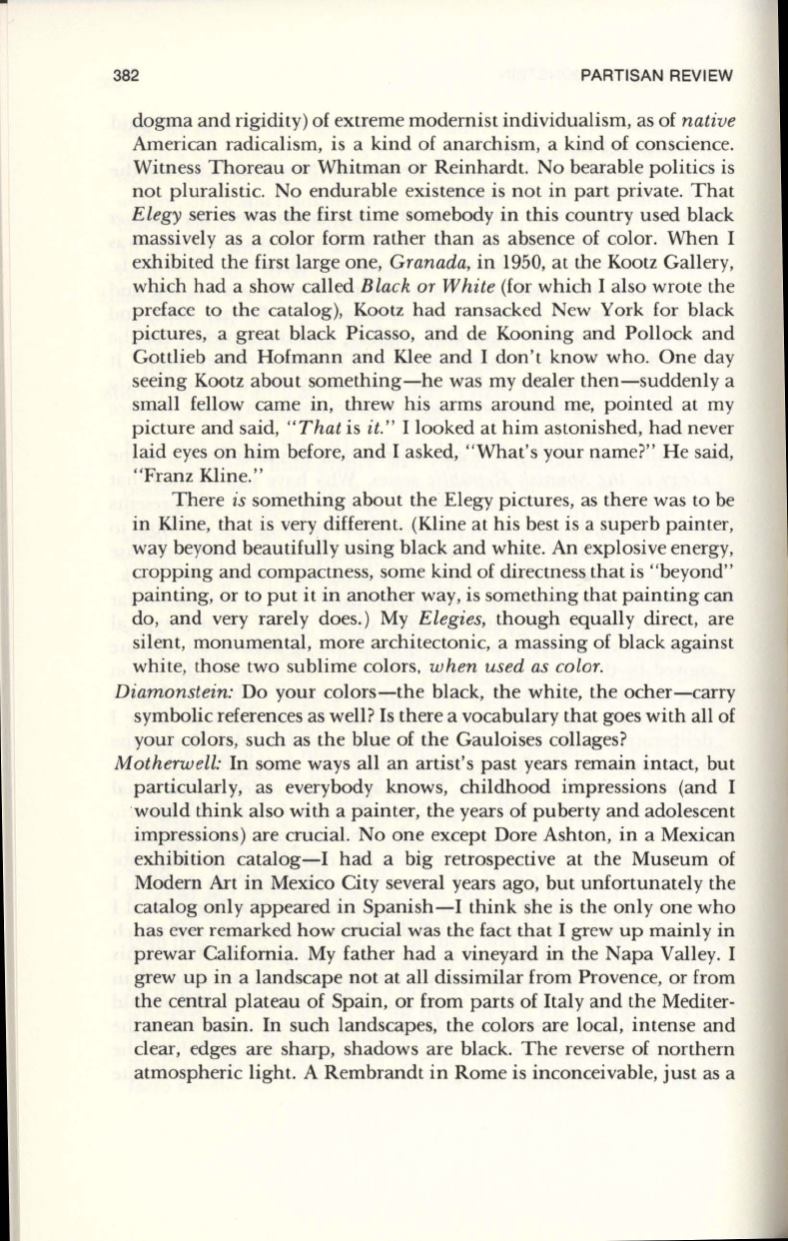
382
PARTISAN REVIEW
dogma and rigidity) of extreme modernist individualism, as of
native
American radicalism, is a kind of anarchism, a kind of conscience.
Witness Thoreau or Whitman or Reinhardt. No bearable politics is
not pluralistic. No endurable existence is not in part private. That
Elegy
series was the first time somebody in this country used black
massively as a color form rather than as absence of color. When I
exhibited the first large one,
Granada,
in 1950, at the Kootz Gallery,
which had a show called
Black
or
White
(for which I also wrote the
preface to the catalog), Kootz had ransacked New York for black
pictures, a great black Picasso, and de Kooning and Pollock and
Gottlieb and Hofmann and Klee and I don' t know who. One day
seeing Kootz about something-he was my dealer then-suddenly a
small fellow came in, threw his arms around me, pointed at my
picture and said,
" That
is
it."
I looked at him astonished, had never
laid eyes on him before, and I asked, "What's your name?" He said,
"Franz Kline. "
There
is
something about the Elegy pictures, as there was to be
in Kline, that is very different. (Kline at his best is a superb painter,
way beyond beautifuily using black and white. An explosive energy,
cropping and compactness, some kind of directness that is "beyond"
painting, or to put it in another way, is something that painting can
do, and very rarely does.) My
Elegies,
though equally direct, are
silent, monumental, more architectonic, a massing of black against
white, those two sublime colors,
when used as color.
Diamonstein:
Do your colors-the black, the white, the ocher-carry
symbolic references as well? Is there a vocabulary that goes with all of
your colors, such as the blue of the Gauloises collages?
Motherwell:
In some ways all an artist's past years remain intact, but
particularly, as everybody knows, childhood impressions (and I
'would think also with a painter, the years of puberty and adolescent
impressions) are crucial. No one except Dore Ashton, in a Mexican
exhibition catalog-I had a big retrospective at the Museum of
Modern Art in Mexico City several years ago, but unfortunately the
catalog only appeared in Spanish-I think she is the only one who
has ever remarked how crucial was the fact that I grew up mainly in
prewar California. My father had a vineyard in the Napa Valley. I
grew up in a landscape not at all dissimilar from Provence, or from
the central plateau of Spain, or from parts of Italy and the Mediter–
ranean basin. In such landscapes, the colors are local, intense and
clear, edges are sharp, shadows are black. The reverse of northern
atmospheric light. A Rembrandt in Rome is inconceivable, just as a


